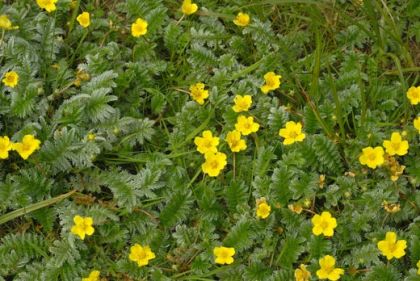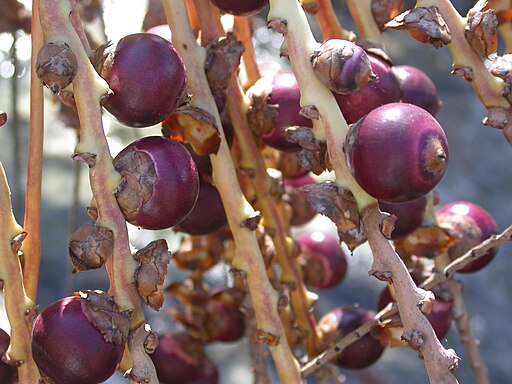However, there are a few possibilities to grow some starch, at Arctic locations.
One wild native plant to Iceland, Silverweed (Potentila anserina) is a strawberry-like creeping plant, that produces swollen roots, that can be cooked as if it would be pasta. However, it was mostly used as a famine food, since the roots are not very thick and are tricky to harvest. The plant grows perfectly in sandy, acidic, gravely and infertile soils.
 |
| Silverweed, a source of starchy roots in the Arctic |
Another crop is Lyme Grass (Leymus arenarius or Elymus arenarius). This grain grass grows in the sandy beaches of the Arctic, and its grain can be grinded into flour or cooked like rice. In fact, the Inuit people and the Vikings used this grain as a staple food, many centuries ago. It is reported to be much richer in protein than conventional cereals. It grows only in sand and it is a perennial. The plant has been widely used in Iceland to stop drifting sand and erosion.
 |
| Lyme grass is perhaps the easiest grain to grow in the Arctic climate, growing in sandy plains. |
Another species that is also native to coastal Arctic locations is Oyster plant (Mertensia maritima). The leaves can be eaten raw or cook, they are rich in vitamins but have a thick mucilagenous texture. The Oyster plant grows in the beaches and can be easily confused with the Sea Sandwort (Honckenya peploides), which also has edible raw stems and leaves, but without the bluish color.
 |
| The Oyster plant has thick edible leaves, near coastal Arctic locations |
Besides these Arctic species, one can also use:
- the syrup from Birch trees, eat Angelica roots
- spice the food with Lovage
- cook the nutritious Dandelion, Chickweed and Nettle greens.
- harvest endless Blueberries, Currants and other wild berries, by late summer
Birch (Betula pubescens) also has edible bark, which can be grinded into flour. The leaves can also be cooked (I tried them raw but the taste is unpleasant). Supposedly also the catkins (which birds love to eat). However birch is generally bitter, and generally only a famine food.
Spruce (Picea sitchensis) also has edible inner bark (mostly used as a famine food), edible raw young shots and edible raw seeds (unfortunarely tiny).
 |
| Spruce, one the most widespread trees in the Arctic, has some edible uses |
| Birch, the only tree native to Iceland, has also edible uses |
If you travel inland into the Arctic tundra, many of the trees and coastal plants mentioned before, are not present. One of the few edible plants in the Icelandic highlands is Moss Campion (Silene acaulis). It can be cooked entirely, but it contains saponins, so it is recommended for large consumption (and cooking water should be changed several times).
 |
| Moss Campion, an edible option if you are at the tundra highlands of the Arctic |
Finally, we have the widespread Northern Dock (Rumex longifolius), these species has edible leaves when cooked, very rich in vitamin C (these should not be eaten in large amount due to containing oxalic acid, which blocks the adsorption of calcium). The Rumex also has edible seeds (similar to amaranth or quinoa), that can be grinded to flour or added to breakfast cereals.
 |
| Northern Dock (Rumex longifolius) produces edible seeds in incredible large amount |
I will be posting my experiences with eating wild plants in Iceland. PS: always take care, when you harvest wild plants for food. Be extra sure of the identification, similar looking species, and possible dangers.
Hope you enjoyed this original post!

_nuytsia_pix.jpg/220px-Jubaea_chilensis_(Fruit_and_nut)_nuytsia_pix.jpg)




